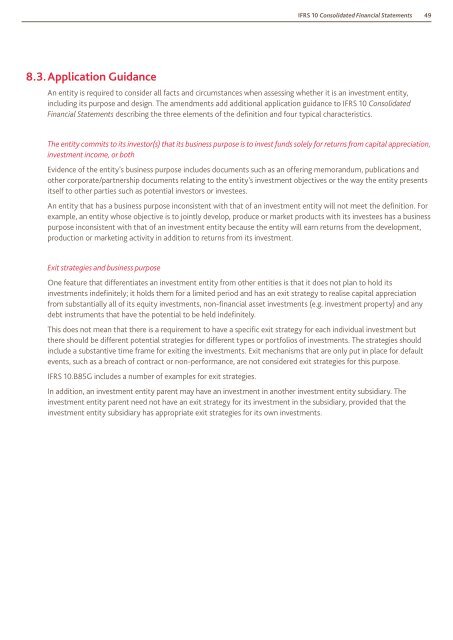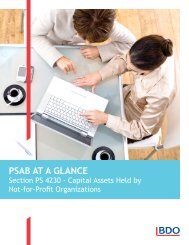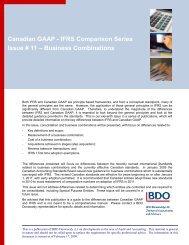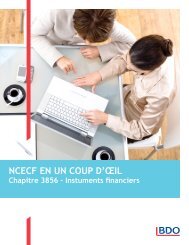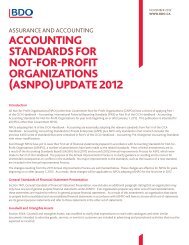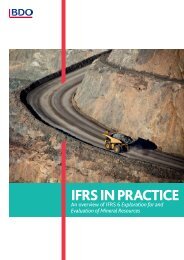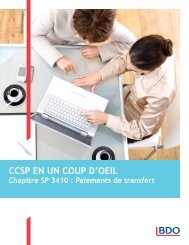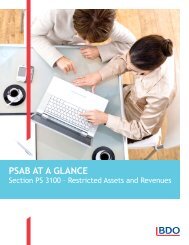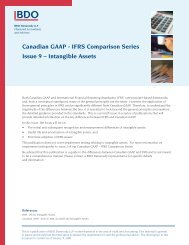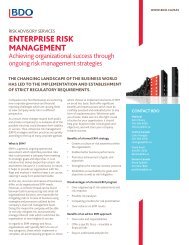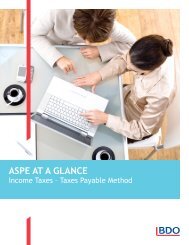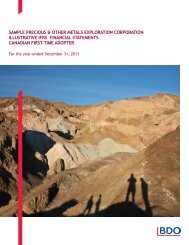Need to Know: IFRS 10 - Consolidated Financial ... - BDO Canada
Need to Know: IFRS 10 - Consolidated Financial ... - BDO Canada
Need to Know: IFRS 10 - Consolidated Financial ... - BDO Canada
- No tags were found...
Create successful ePaper yourself
Turn your PDF publications into a flip-book with our unique Google optimized e-Paper software.
<strong>IFRS</strong> <strong>10</strong> <strong>Consolidated</strong> <strong>Financial</strong> Statements498.3. Application GuidanceAn entity is required <strong>to</strong> consider all facts and circumstances when assessing whether it is an investment entity,including its purpose and design. The amendments add additional application guidance <strong>to</strong> <strong>IFRS</strong> <strong>10</strong> <strong>Consolidated</strong><strong>Financial</strong> Statements describing the three elements of the definition and four typical characteristics.The entity commits <strong>to</strong> its inves<strong>to</strong>r(s) that its business purpose is <strong>to</strong> invest funds solely for returns from capital appreciation,investment income, or bothEvidence of the entity’s business purpose includes documents such as an offering memorandum, publications andother corporate/partnership documents relating <strong>to</strong> the entity’s investment objectives or the way the entity presentsitself <strong>to</strong> other parties such as potential inves<strong>to</strong>rs or investees.An entity that has a business purpose inconsistent with that of an investment entity will not meet the definition. Forexample, an entity whose objective is <strong>to</strong> jointly develop, produce or market products with its investees has a businesspurpose inconsistent with that of an investment entity because the entity will earn returns from the development,production or marketing activity in addition <strong>to</strong> returns from its investment.Exit strategies and business purposeOne feature that differentiates an investment entity from other entities is that it does not plan <strong>to</strong> hold itsinvestments indefinitely; it holds them for a limited period and has an exit strategy <strong>to</strong> realise capital appreciationfrom substantially all of its equity investments, non-financial asset investments (e.g. investment property) and anydebt instruments that have the potential <strong>to</strong> be held indefinitely.This does not mean that there is a requirement <strong>to</strong> have a specific exit strategy for each individual investment butthere should be different potential strategies for different types or portfolios of investments. The strategies shouldinclude a substantive time frame for exiting the investments. Exit mechanisms that are only put in place for defaultevents, such as a breach of contract or non-performance, are not considered exit strategies for this purpose.<strong>IFRS</strong> <strong>10</strong>.B85G includes a number of examples for exit strategies.In addition, an investment entity parent may have an investment in another investment entity subsidiary. Theinvestment entity parent need not have an exit strategy for its investment in the subsidiary, provided that theinvestment entity subsidiary has appropriate exit strategies for its own investments.


